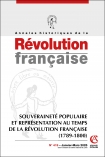
Revue de l'histoire des religions (4/2008)
Numéro épuisé
Recevez les numéros de l'année en cours et accédez à l'intégralité des articles en ligne.
Après avoir établi l’authenticité, l’édition critique princeps et la traduction de l’Annotation brève sur Daniel, nous montrons en quoi l’exégèse d’Haymon, moine à Saint-Germain d’Auxerre au milieu du IXe s., témoigne de la réussite du renouveau carolingien. Attentif à la correction du texte biblique, il utilise la révision réputée peu diffusée de Théodulfe d’Orléans. Pillé par la Glose ordinaire, il est lu durant tout le Moyen Âge jusqu’à l’époque humaniste. Commentateur des prophètes, il actualise leur admonition en exaltant une sainteté monastique. Le mouvement réformateur carolingien, encouragé par les rois, se retourne contre eux dans l’œuvre d’Haymon : ce dernier prépare l’ecclésiologie de ses confrères des Xe - XIe siècles.
Firstly we state the authenticity and establish the previously unpublished text and translation of the Adnotatio breuis in Danielemof Haimo, monk at Saint-Germain d’Auxerre (mid. IXth cent.). We then show how the fruitful achievements of the Carolingian revival are enlightened by Haimo’s practice of exegesis. As his consistent use of the Theodulfian recension shows, he was deeply concerned in the Bible. Later, he was plundered by the Glossa ordinaria and constantly read until the Humanistic period. As a commentator on the Prophets, he adapts their admonitio to his own time by exalting monastic holiness. The Carolingian reforming movement that was encouraged by the kings thus finally turns against these in the works of Haimo, a forerunner of the X th - XI th cent. monks’ ecclesiology

